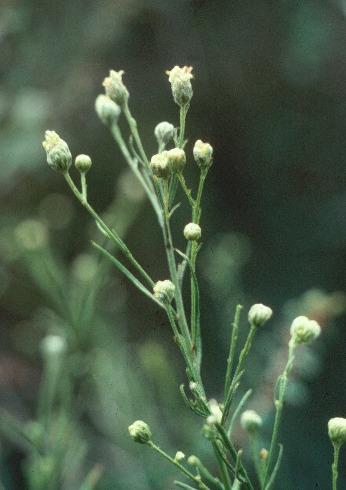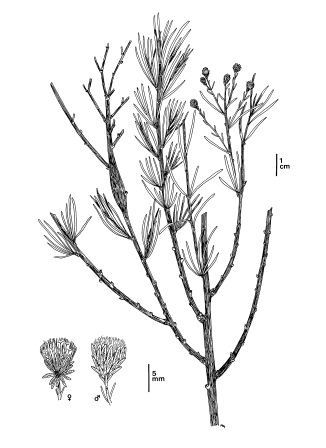(Baccharis vanessae)
 Baccharis vanessae. CDFW photo by Susan Levitsky.
Baccharis vanessae. CDFW photo by Susan Levitsky.
 Baccharis vanessae. CDFW illustration by Mary Ann Showers. (Click to enlarge)
Baccharis vanessae. CDFW illustration by Mary Ann Showers. (Click to enlarge)
Encinitas baccharis is a California endangered plant species, which means that killing or possessing the plant is prohibited by the California Endangered Species Act (CESA). Encinitas baccharis is a medium-sized shrub with small, inconspicuous flowers. The species is dioecious, which means that each plant either has male flowers or female flowers, but not both. It is likely pollinated by wind and insects, typically blooming from August to November. Encinitas baccharis is also listed as threatened by the federal Endangered Species Act.
Encinitas baccharis is a pioneer species, which means that its numbers increase after a disturbance to the environment, such as fire, erosions, or landslides. It is not able to compete well with tall, leafy shrubs, so it is threatened by succession in fire-suppressed areas. Encinitas baccharis occurs in several chaparral habitat types below 3,000 feet in maritime climates. Its known range is from northern San Diego County in the Cleveland National Forest south to Encinitas and east to Alpine, with most occupied areas occurring between Carlsbad and Encinitas. At the time of this webpage posting, the California Natural Diversity Database lists 21 occurrences that are presumed to still exist.
Encinitas baccharis is threatened by habitat loss and alteration resulting from development, though this threat has recently decreased through its inclusion in habitat conservation plans such as the Multiple Species Conservation Program – County of San Diego Subarea Plan and City of San Diego Subarea Plan. However, there are no monitoring or management actions in place at conserved occurrences that would assess population changes. Encinitas baccharis is also threatened by the lack of an appropriate fire regime, especially in occurrences that are near urbanized developments, low population numbers and its low observed reproduction success. Other threats include fire suppression actions, invasion of non-native plants, extinction by stochastic events due to small population size, and climate change. In order to ensure the persistence of Encinitas baccharis, historic and current occurrences should be surveyed to assess population statuses, and occurrences should be managed to maintain both sexes of plants to facilitate reproduction. Additionally, occurrences should be protected on private lands and disturbance should be implemented to mimic its natural fire regime.
CDFW may issue permits for Encinitas baccharis pursuant to CESA, and you can learn more about the California laws protecting Encinitas baccharis and other California native plants. Populations of Encinitas baccharis occur in CDFW’s South Coast Region. More information is also available from the U.S. Fish and Wildlife Service Species Profile for Encinitas baccharis.
Updated 12/8/2015